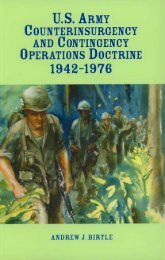C. Wiebes - Intelligence en de oorlog in Bosnië 1992-1995. De rol van de inlichtingen- en veiligheidsdiensten - Engels
C. Wiebes - Intelligence en de oorlog in Bosnië 1992-1995. De rol van de inlichtingen- en veiligheidsdiensten - Engels
C. Wiebes - Intelligence en de oorlog in Bosnië 1992-1995. De rol van de inlichtingen- en veiligheidsdiensten - Engels
- No tags were found...
You also want an ePaper? Increase the reach of your titles
YUMPU automatically turns print PDFs into web optimized ePapers that Google loves.
314Speculation was rife not only <strong>in</strong> the press. This question was also put to Akashi by New York.On the day of the fall of Srebr<strong>en</strong>ica Annan <strong>de</strong>clared that the situation raised serious and urg<strong>en</strong>tquestions for UNPROFOR:‘How was it that UNPROFOR was tak<strong>en</strong> unaware aga<strong>in</strong>, as with Goraz<strong>de</strong> andBihac last year, by the true ext<strong>en</strong>t of Serb <strong>in</strong>t<strong>en</strong>tions? What <strong>in</strong>tellig<strong>en</strong>ceresources do you [Akashi] have and what <strong>in</strong>formation, if any, was provi<strong>de</strong>d toUNPROFOR by those troop-contribut<strong>in</strong>g nations with <strong>in</strong>tellig<strong>en</strong>ce-gather<strong>in</strong>gassets <strong>in</strong> the area?’Annan cont<strong>in</strong>ued: ‘I f<strong>in</strong>d it difficult to accept that no “early warn<strong>in</strong>g” was possible wh<strong>en</strong> the evid<strong>en</strong>cesuggests that a major build-up of troops and heavy weapons by the VRS occurred prior to theoff<strong>en</strong>sive’. 1724 It was to prove no easy matter to answer this.The c<strong>en</strong>tral question <strong>in</strong> this chapter is whether <strong>in</strong>tellig<strong>en</strong>ce and security services or other directly<strong>in</strong>volved parties had prior knowledge of the VRS plans for the attack on Srebr<strong>en</strong>ica, or <strong>in</strong> other wordswhether they were forewarned. Were there <strong>in</strong>tellig<strong>en</strong>ce <strong>in</strong>dications before the attack that the VRSplanned to reduce the <strong>en</strong>clave <strong>in</strong> size or possible to conquer it <strong>en</strong>tirely? And if these <strong>in</strong>dications werereceived <strong>in</strong> time, who gathered or withheld this dramatic <strong>in</strong>formation, and why?The answer is to be found <strong>in</strong> the <strong>in</strong>tellig<strong>en</strong>ce situation of various <strong>in</strong>tellig<strong>en</strong>ce and securityservices on the eve of the fall. In the process, a dist<strong>in</strong>ction must be drawn betwe<strong>en</strong> ‘strategic’ and‘tactical’ prior knowledge, or forewarn<strong>in</strong>g. Strategic prior knowledge relates to the patterns ofexpectation ext<strong>en</strong>d<strong>in</strong>g over a long period. This knowledge existed <strong>in</strong> pl<strong>en</strong>ty, because the Bosnian Serbshad oft<strong>en</strong> <strong>de</strong>clared that they would one day take over the <strong>en</strong>claves. Various officials of one European<strong>in</strong>tellig<strong>en</strong>ce service thus expected that the eastern <strong>en</strong>claves would be conquered sooner or later, andthey were not surprised wh<strong>en</strong> this f<strong>in</strong>ally happ<strong>en</strong>ed. 1725 A memorandum from the MIS/Army writt<strong>en</strong> <strong>in</strong>June 1995 predicted that the t<strong>en</strong>sion around the eastern <strong>en</strong>claves would cont<strong>in</strong>ue unabated, and would<strong>in</strong>crease ev<strong>en</strong> further if the smuggl<strong>in</strong>g of weapons and ammunition from Zepa to Srebr<strong>en</strong>ica were tocont<strong>in</strong>ue. An attack on the <strong>en</strong>clave was not expected, but attempts to create better l<strong>in</strong>es ofcommunication were forecast. 1726 But as a member of the MIS/Army <strong>de</strong>clared after the fall: suchstrategic <strong>in</strong>dications offer little or no practical <strong>in</strong>sight. The core of <strong>in</strong>tellig<strong>en</strong>ce work is formed bytactical <strong>in</strong>dications, such as troop conc<strong>en</strong>trations, tanks, trucks and new tr<strong>en</strong>ches. 1727If these tactical <strong>in</strong>dications were not noted, th<strong>en</strong> the attack on Srebr<strong>en</strong>ica should <strong>in</strong><strong>de</strong>ed beregar<strong>de</strong>d as an ‘<strong>in</strong>tellig<strong>en</strong>ce failure’. Section 2 first provi<strong>de</strong>s a <strong>de</strong>scribtion of this term. The primarycauses of such a failure are <strong>de</strong>scribed; this may relate to a lack of <strong>in</strong>tellig<strong>en</strong>ce, or to a failure to correctly<strong>in</strong>terpret, or to evaluate <strong>in</strong> time, the <strong>in</strong>tellig<strong>en</strong>ce which did exist.Section 3 th<strong>en</strong> exam<strong>in</strong>es strategic prior knowledge. The issue here is whether it was expectedthat the Srebr<strong>en</strong>ica <strong>en</strong>clave would disappear <strong>in</strong> the long term, either as a result of political negotiationsor through an attack. Section 4 <strong>de</strong>als with <strong>in</strong>tellig<strong>en</strong>ce aspects of the actual course of the attack on the<strong>en</strong>clave. 1728 Section 5 turns to the <strong>in</strong>formation situation of UNPROFOR, and looks at the tactical priorknowledge <strong>in</strong> more <strong>de</strong>tail. The question asked here is whether any prior knowledge based on hard<strong>in</strong>dications really existed. This <strong>in</strong>volves an exam<strong>in</strong>ation of the Signals <strong>Intellig<strong>en</strong>ce</strong> (Sig<strong>in</strong>t), Imagery<strong>Intellig<strong>en</strong>ce</strong> (Im<strong>in</strong>t) and Human <strong>Intellig<strong>en</strong>ce</strong> (Hum<strong>in</strong>t) gathered by the various national <strong>in</strong>tellig<strong>en</strong>ceservices. An important question is whether this <strong>in</strong>formation was shared with the UN or the troopcontribut<strong>in</strong>gnations. Th<strong>en</strong> the various parties <strong>in</strong> the <strong>en</strong>clave are <strong>de</strong>alt with, such as Dutchbat, theJCOs, UNHCR, NGOs and the ABiH. The Sig<strong>in</strong>t capabilities of the ABiH are analysed. If these players1724 Confid<strong>en</strong>tial collection (7); Annan to Akashi, ‘situation <strong>in</strong> Srebr<strong>en</strong>ica’, No. 2280, 11/07/95.1725 Confid<strong>en</strong>tial <strong>in</strong>terview (48).1726 MoD, SMG, IntSum MIS/Army, <strong>De</strong>partm<strong>en</strong>t I&V, 010609-070695, 07/06/95.1727 MoD, SMG, Report of a conversation with an Military <strong>Intellig<strong>en</strong>ce</strong> Service official, 03/08/95.1728 The attack itself is <strong>de</strong>scribed <strong>in</strong> <strong>de</strong>tail <strong>in</strong> Chapter 6 of Part III of the ma<strong>in</strong> Srebr<strong>en</strong>ica report.





